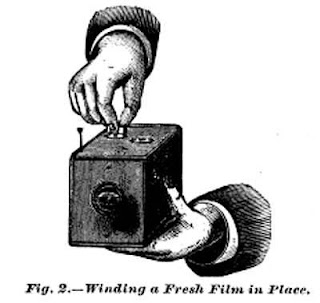“You press the button, we do the rest.”
In 1885 George Eastman marketed the first transparent photographic "film," which was flexible and easily wound onto a spindle. This film was created by coating the photographic emulsion on paper and then loading the paper in a roll holder. Because the grain of the paper was often transferred onto the photograph, Eastman searched for a better carrier of the emulsion. The solution came in the form of a soluble gelatin, which would coat the paper. The gelatin would then be covered with a layer of insoluble gelatin, which was light-sensitive. Once exposed and developed, the gelatin was pulled from the paper and moved to a sheet made of clear gelatin. The sheet was then finished with collodion, which made the film durable, yet flexible. This became the first commercial transparent roll film, released in 1889. The method of using film replaced the complicated process involving all of the chemicals, tanks, and plate holders which was only available to professionals and those seriously interested in the process of photography.
The development of the roll film allowed for the Kodak camera to be placed on the market in 1888. The camera came pre-loaded with enough film for 100 exposures (200 feet of film!), but still compact enough to carry around. Once the user had taken all the shots, the camera could be taken to the Kodak company in New York. There, the film was developed and prints were made. Kodak then replaced the film, and returned the camera to the owner. The Kodak camera was appealing to the middle class because of its fairly low cost and the ease of use.
To use the camera, there were three easy steps:
1. Turning the key to wind the film
2. Pulling the string to set the shutter
3. Pressing the button to take a photo
For many, the Kodak camera made the process of taking photographs simpler. The simplicity of the camera and the extensive marketing done by the Eastman-Kodak company made photography popular and accessible to amateurs; photography was made into an “everyday affair.”
The popularity of the Kodak was so great, that users were getting in trouble for taking photographs they shouldn’t be. Kodaks were banned from some beaches after the “camera fiend” was caught trying to take photos of women in their bathing suits. Others were afraid they would be caught on camera looking ridiculous, but that was the goal for many people. The Kodak could capture the spontaneity of the moment, compared to the seriousness and stillness of the wet-plate predecessors. After the film camera was released in 1888, many soon followed, allowing for the further spread of amateur photography.
References:
http://videopreservation.conservation-us.org/library/ history_storage_of_cellulose_nitrate_film_v26.pdf
Lemels N-MIT, "Inventor of the Week Archive: Dry, transparent, and flexible photographic films."
NNDB, "George Eastman."
Patent Plaques, "Invention of the Roll Film Camera: You Press The Button, We Do The Rest
PBS, "The Kodak Camera Starts a Craze."
Wired.com, "September 4, 1888: Photography Leaps into the Late 19th Century.






No comments:
Post a Comment